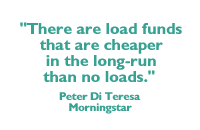NEW YORK (CNNfn) - Unless you've just come out of a 10-year coma, chances are you know enough about mutual funds to ask, "Why should I pay a sales charge to invest in a fund when I can just as well buy a comparable no-load?"
You may think you'll automatically save a bundle by steering clear of funds with front-end loads, which are commissions paid to a financial adviser, broker or, less commonly, the fund company itself. But if you're investing for the long haul, the truth is some load funds are actually cheaper, experts say.
You just need to be sure you're picking a fund whose expenses are below average.
Count your losses before they hatch
For an equity fund, front-end loads typically run between 4 percent and 5 percent of the amount you want to invest, and are taken off the top before your money is put in the fund. So if you are parting with $10,000, you actually will only be investing between $9,500 and $9,600.
 That may seem lousy. But keep in mind that all mutual funds -- loads and no-loads -- charge investors fees for management, performance, and administrative and distribution services that affect your return. That may seem lousy. But keep in mind that all mutual funds -- loads and no-loads -- charge investors fees for management, performance, and administrative and distribution services that affect your return.
These fees are accounted for in what's called the expense ratio, which indicates what you must pay annually for every $100 you have in the fund, regardless of whether you make or lose money.
The higher the ratio, the more you pay and the lower your actual return. If your fund gains 10 percent in the market one year, the return you see will be that minus the expense ratio. So if the expense ratio is 1 percent -- or 100 basis points -- the reported return will actually be 9 percent for the year.
When a no-load doesn't pay
So when comparing funds, "the real issue is the expense ratio," said Bill Dougherty, a retirement planning consultant and president of the investment adviser firm Kanon Bloch Carre. "A difference of 50 basis points is a killer over a long period of time."
Say a 25-year-old with $5,000 to invest is considering two funds -- one with an expense ratio of 1 percent and another with just 0.5 percent. Presuming he invests 6 percent of his income annually, and his salary grows at 8 percent a year, if the funds deliver an 8 percent annual return, he may lose as much as $250,000 after 35 years if he chooses the fund with the 1 percent ratio, Dougherty said.
But what if the lower-cost fund comes with a load? The investor may still come out ahead.

"There are load funds that are cheaper in the long run than no-loads," said Peter Di Teresa, a senior editorial analyst at fund-tracker Morningstar.
By long run, Di Teresa means at least 10 years, which is usually how long it takes for the wonders of compounding to overtake the one-two punch of upfront sales charges.
Presuming a steady return of 10 percent, Dougherty added, you may well pay more and net less on a 10-year investment in a no-load with a 1.1 percent expense ratio than you would a fund carrying a 4.5 percent load and a 0.6 percent expense ratio.
Are loads really for you?
There's no question, experts say, that if you're a savvy investor and are willing to do your homework, you can do just fine -- indeed better - - putting money into no-load funds with minimal expenses.
"If you can do it yourself, why bother with loads?" Dougherty said.
Especially if a fund carries a high expense ratio and what's known as a back-end load, payable when you sell the fund. Or if you're considering buying a bond fund with a sales charge. "Load funds have a serious liability in the bond arena," Di Teresa said, primarily because they tend to have low returns, which lessens their compounding effect and makes it harder for you to play catch-up.
But if you're not comfortable investing on your own, you might find a financial adviser helpful.
"A mentality has set in that you should never get help with your finances. But some people would benefit," said Morningstar analyst Scott Cooley.

Who exactly? For starters, people nearing retirement with more in their 401(k) than they ever thought possible, especially if they're considering moving some or all of that money into an IRA, Cooley said.
Young investors are not exempt either. One couple Cooley knows is in their 30s and make a very good living -- she's an advertising executive, he's an attorney. Yet for years, they managed to save nothing. Then they began working with an adviser, who showed them how to cut $1,500 from their monthly expenses. They now happily pay for load funds that their adviser oversees.
Getting a load for free
You also might consider load funds if you're buying into a 401(k) plan. Participants in the plan are usually not charged the load, but are allowed to invest in the fund anyway, Dougherty said.
And, if you're a high net-worth individual, load funds with low expenses might prove a bargain. The more you invest in a fund, the less you're charged. You can check with the fund to see what its "break points" are.
For instance, Washington Mutual Investors charges a 5.75 percent load for investments up to $49,999. If you invest $499,999, however, the load is reduced to 2.5 percent, and if you put in $1 million or more, consider yourself load-free.
However you've handled your investments until now, and however much you have to invest going forward, it's comforting to know that your choices are broader, better and in some ways less expensive than before.
If you're revising your knee-jerk reaction to commissions or are simply reviewing the ones you've already paid, you might consider this:
"When you buy a load you tend to have the discipline to hold it longer," Dougherty said. And discipline, coupled with solid returns and low expenses, can make for a very successful investment. 
|

